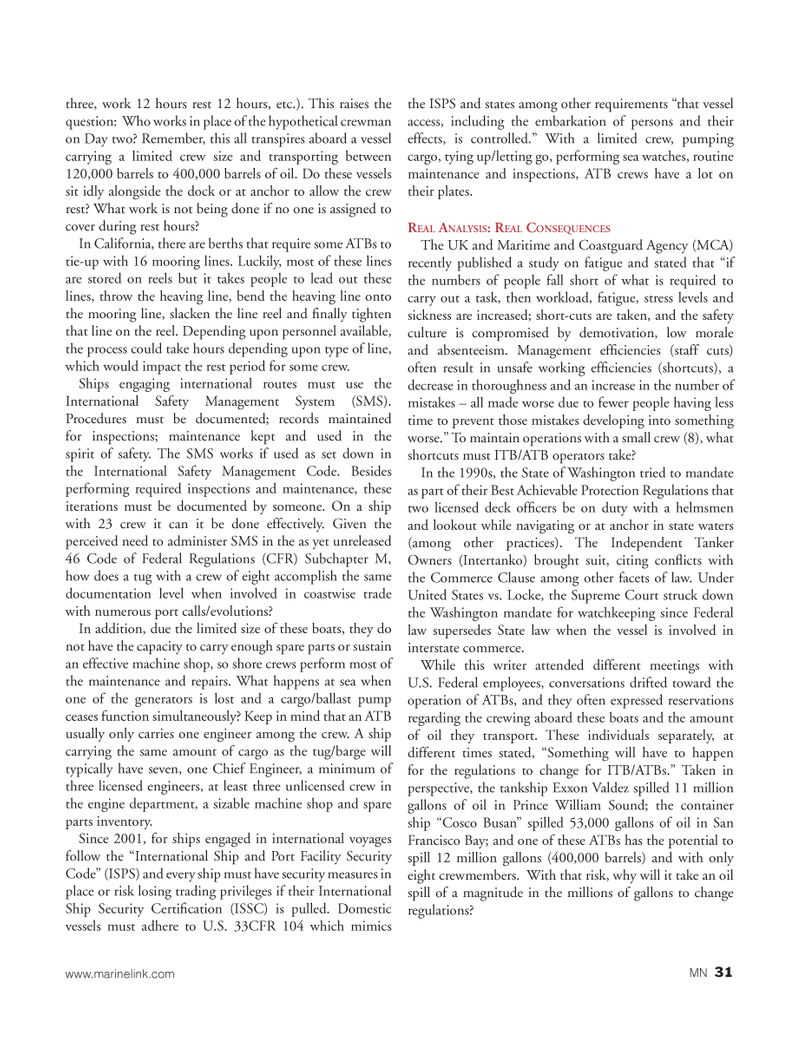
Page 31: of Marine News Magazine (February 2013)
Bulk Transport Leadership Roundtable
Read this page in Pdf, Flash or Html5 edition of February 2013 Marine News Magazine
three, work 12 hours rest 12 hours, etc.). This raises the question: Who works in place of the hypothetical crewman on Day two? Remember, this all transpires aboard a vessel carrying a limited crew size and transporting between 120,000 barrels to 400,000 barrels of oil. Do these vessels sit idly alongside the dock or at anchor to allow the crew rest? What work is not being done if no one is assigned to cover during rest hours? In California, there are berths that require some ATBs to tie-up with 16 mooring lines. Luckily, most of these lines are stored on reels but it takes people to lead out these lines, throw the heaving line, bend the heaving line onto the mooring line, slacken the line reel and Þ nally tighten that line on the reel. Depending upon personnel available, the process could take hours depending upon type of line, which would impact the rest period for some crew. Ships engaging international routes must use the International Safety Management System (SMS). Procedures must be documented; records maintained for inspections; maintenance kept and used in the spirit of safety. The SMS works if used as set down in the International Safety Management Code. Besides performing required inspections and maintenance, these iterations must be documented by someone. On a ship with 23 crew it can it be done effectively. Given the perceived need to administer SMS in the as yet unreleased 46 Code of Federal Regulations (CFR) Subchapter M, how does a tug with a crew of eight accomplish the same documentation level when involved in coastwise trade with numerous port calls/evolutions? In addition, due the limited size of these boats, they do not have the capacity to carry enough spare parts or sustain an effective machine shop, so shore crews perform most of the maintenance and repairs. What happens at sea when one of the generators is lost and a cargo/ballast pump ceases function simultaneously? Keep in mind that an ATB usually only carries one engineer among the crew. A ship carrying the same amount of cargo as the tug/barge will typically have seven, one Chief Engineer, a minimum of three licensed engineers, at least three unlicensed crew in the engine department, a sizable machine shop and spare parts inventory. Since 2001, for ships engaged in international voyages follow the ÒInternational Ship and Port Facility Security CodeÓ (ISPS) and every ship must have security measures in place or risk losing trading privileges if their International Ship Security CertiÞ cation (ISSC) is pulled. Domestic vessels must adhere to U.S. 33CFR 104 which mimics the ISPS and states among other requirements Òthat vessel access, including the embarkation of persons and their effects, is controlled.Ó With a limited crew, pumping cargo, tying up/letting go, performing sea watches, routine maintenance and inspections, ATB crews have a lot on their plates.REAL ANALYSIS : REAL CONSEQUENCES The UK and Maritime and Coastguard Agency (MCA) recently published a study on fatigue and stated that Òif the numbers of people fall short of what is required to carry out a task, then workload, fatigue, stress levels and sickness are increased; short-cuts are taken, and the safety culture is compromised by demotivation, low morale and absenteeism. Management efÞ ciencies (staff cuts) often result in unsafe working efÞ ciencies (shortcuts), a decrease in thoroughness and an increase in the number of mistakes Ð all made worse due to fewer people having less time to prevent those mistakes developing into something worse.Ó To maintain operations with a small crew (8), what shortcuts must ITB/ATB operators take? In the 1990s, the State of Washington tried to mandate as part of their Best Achievable Protection Regulations that two licensed deck ofÞ cers be on duty with a helmsmen and lookout while navigating or at anchor in state waters (among other practices). The Independent Tanker Owners (Intertanko) brought suit, citing conß icts with the Commerce Clause among other facets of law. Under United States vs. Locke, the Supreme Court struck down the Washington mandate for watchkeeping since Federal law supersedes State law when the vessel is involved in interstate commerce. While this writer attended different meetings with U.S. Federal employees, conversations drifted toward the operation of ATBs, and they often expressed reservations regarding the crewing aboard these boats and the amount of oil they transport. These individuals separately, at different times stated, ÒSomething will have to happen for the regulations to change for ITB/ATBs.Ó Taken in perspective, the tankship Exxon Valdez spilled 11 million gallons of oil in Prince William Sound; the container ship ÒCosco BusanÓ spilled 53,000 gallons of oil in San Francisco Bay; and one of these ATBs has the potential to spill 12 million gallons (400,000 barrels) and with only eight crewmembers. With that risk, why will it take an oil spill of a magnitude in the millions of gallons to change regulations? www.marinelink.com MN 31MN Feb2013 Layout 18-31.indd 31MN Feb2013 Layout 18-31.indd 311/30/2013 4:50:16 PM1/30/2013 4:50:16 PM

 30
30

 32
32
